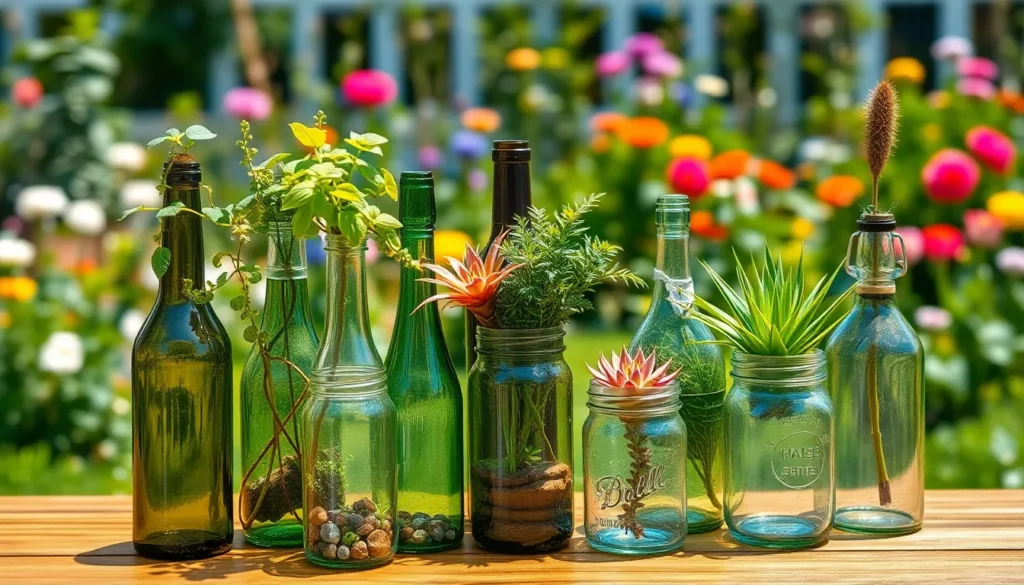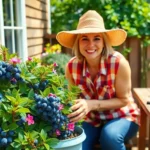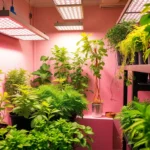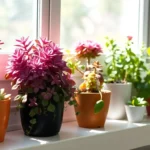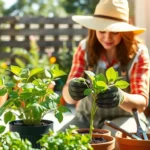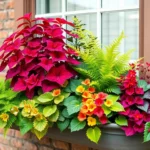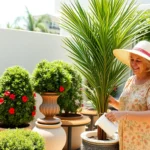We’ve all seen those stunning glass bottle gardens that transform ordinary spaces into miniature green oases. These captivating displays aren’t just Instagram-worthy – they’re surprisingly simple to create and maintain. Whether you’re working with wine bottles mason jars or decorative glass containers the possibilities for your bottle garden are endless.
Glass bottle planters offer the perfect solution for small spaces limited budgets and busy lifestyles. They create their own mini-ecosystems requiring minimal watering while adding a touch of natural beauty to any room. From hanging terrariums to desktop displays these versatile containers work beautifully in homes offices and even outdoor spaces.
The best part? You don’t need a green thumb to succeed with bottle gardening. We’ll show you how to choose the right plants prepare your containers and create thriving miniature gardens that’ll have your friends asking for your secret. Let’s jump into the wonderful industry of glass bottle plant ideas that’ll transform your space.
Hanging Glass Bottle Planters for Vertical Gardens
Transforming vertical spaces with hanging glass bottle planters maximizes our growing potential while creating stunning living walls. These elevated garden answers work perfectly for patios, balconies, and indoor spaces where floor area is limited.
Creating Suspended Air Plant Displays
Air plants thrive in hanging glass bottle environments without requiring soil or frequent watering. We recommend using clear wine bottles with wide openings to showcase these fascinating epiphytes like Spanish moss, Tillandsia xerographica, and pink quill plants.
Preparation steps include:
- Cutting bottle openings to 3-4 inches for easy plant access
- Adding decorative pebbles or sea glass for visual interest
- Installing sturdy rope or chain hangers rated for 2-3 pounds
Plant selection works best with:
- Small air plant varieties that fit bottle dimensions
- Colorful species like Tillandsia cyanea for visual impact
- Multiple plants per bottle for fuller displays
Misting our suspended air plant collections twice weekly keeps them healthy and vibrant. Position these hanging gardens near bright windows or covered outdoor areas with good air circulation.
Installing Wall-Mounted Bottle Gardens
Wall-mounted glass bottle systems create impressive vertical gardens using minimal floor space. We can mount individual bottles or design connected systems that water multiple plants simultaneously.
Installation requirements include:
- Heavy-duty wall anchors supporting 5-10 pounds per bottle
- Drill bits matching anchor sizes for secure mounting
- Level tools ensuring straight, professional-looking arrangements
Plant combinations that work well:
- Trailing succulents like string of pearls cascading downward
- Compact herbs including oregano, thyme, and small basil varieties
- Colorful flowering plants such as petunias and trailing nasturtiums
Water collection systems prevent wall damage by catching excess moisture. Install small drip trays beneath each bottle or design gravity-fed watering channels connecting multiple containers.
Designing Tiered Hanging Systems
Tiered hanging bottle gardens maximize vertical growing space while creating dramatic visual displays. We achieve stunning effects by arranging bottles at different heights and angles throughout our available space.
Design elements include:
| Tier Level | Bottle Height | Recommended Plants | Spacing Distance |
|---|---|---|---|
| Top tier | 6-8 feet | Air plants, succulents | 18-24 inches |
| Middle tier | 4-6 feet | Herbs, small flowers | 12-18 inches |
| Bottom tier | 2-4 feet | Trailing plants, ferns | 8-12 inches |
Construction methods involve:
- Adjustable rope systems allowing height modifications
- Pulley mechanisms for easy plant maintenance access
- Staggered hanging points creating depth and dimension
Watering tiered systems requires planning to prevent dripping onto lower plants. We install individual drip catchers or design overflow systems that direct excess water to designated collection areas.
Repurposed Wine Bottle Herb Gardens
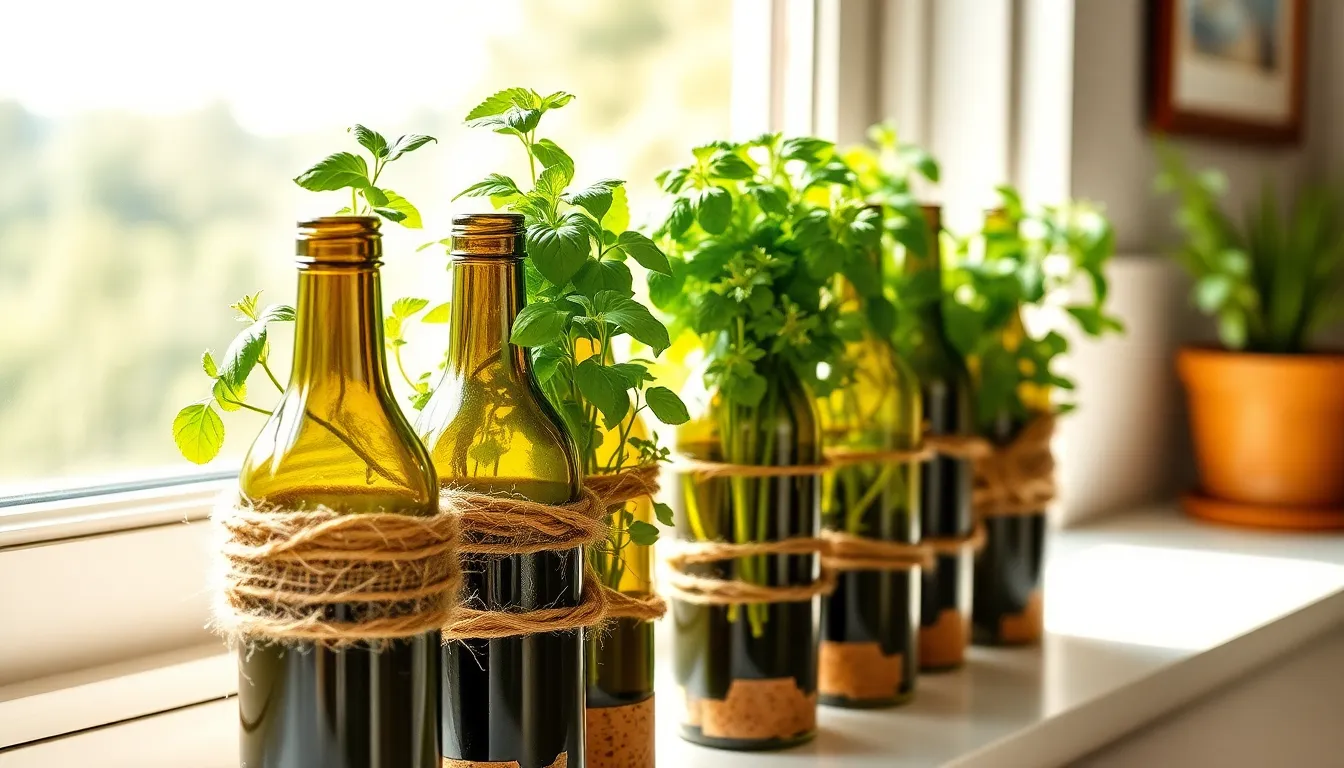
We can transform ordinary wine bottles into thriving herb gardens that bring fresh flavors right to our fingertips. These upcycled planters work perfectly for growing oregano, basil, cilantro, parsley, and tarragon while adding rustic charm to any indoor space.
Converting Wine Bottles into Window Sill Planters
Cutting wine bottles creates excellent window sill planters that maximize our growing space efficiently. We’ll need a bottle cutter, safety equipment, and basic cutting tools to transform the bottom portion of wine bottles into functional pots. Safety should be our top priority when working with glass, so we recommend wearing protective eyewear and gloves throughout the cutting process.
Stabilizing these planters requires simple materials like cork bases or decorative stands that prevent wobbling. We can enhance the aesthetic appeal by wrapping the bottles with jute rope or twine, creating a natural texture that complements most kitchen decors. Drainage becomes crucial for healthy herb growth, so we’ll drill small holes in the bottle bottom or add a layer of pebbles before adding soil.
Building Self-Watering Herb Systems
Self-watering systems eliminate the guesswork from herb cultivation while reducing water waste significantly. We create these systems using wine bottles, window screen pieces, cotton string, quality potting soil, and our chosen herb seedlings. The bottle serves as both planter and water reservoir, making this design incredibly space efficient.
String wicks become the key component that draws water from the reservoir to the soil automatically. We thread the string through holes in the window screen, ensuring one end sits in the water while the other extends into the soil. This wicking action maintains consistent moisture levels without overwatering, which is particularly beneficial for herbs like basil and parsley that prefer steady hydration.
Creating Hydroponic Bottle Gardens
Hydroponic systems using wine bottles offer soil-free growing that’s perfect for indoor herb cultivation. We can create these systems using Grow Bottle kits that include organic seeds, soil-less growing medium, plant nutrients, and wool wicks specifically designed for bottle growing. These components work together to create optimal growing conditions for herbs like basil, parsley, and mint.
Water and nutrient management becomes simplified with these bottle systems since we control exactly what our plants receive. The clear glass allows us to monitor root development and water levels easily, while the compact design fits perfectly on countertops or window sills. These hydroponic bottle gardens produce herbs with intense flavors since the plants receive concentrated nutrition without competing with soil microorganisms for resources.
Terrarium Glass Bottle Plant Ideas
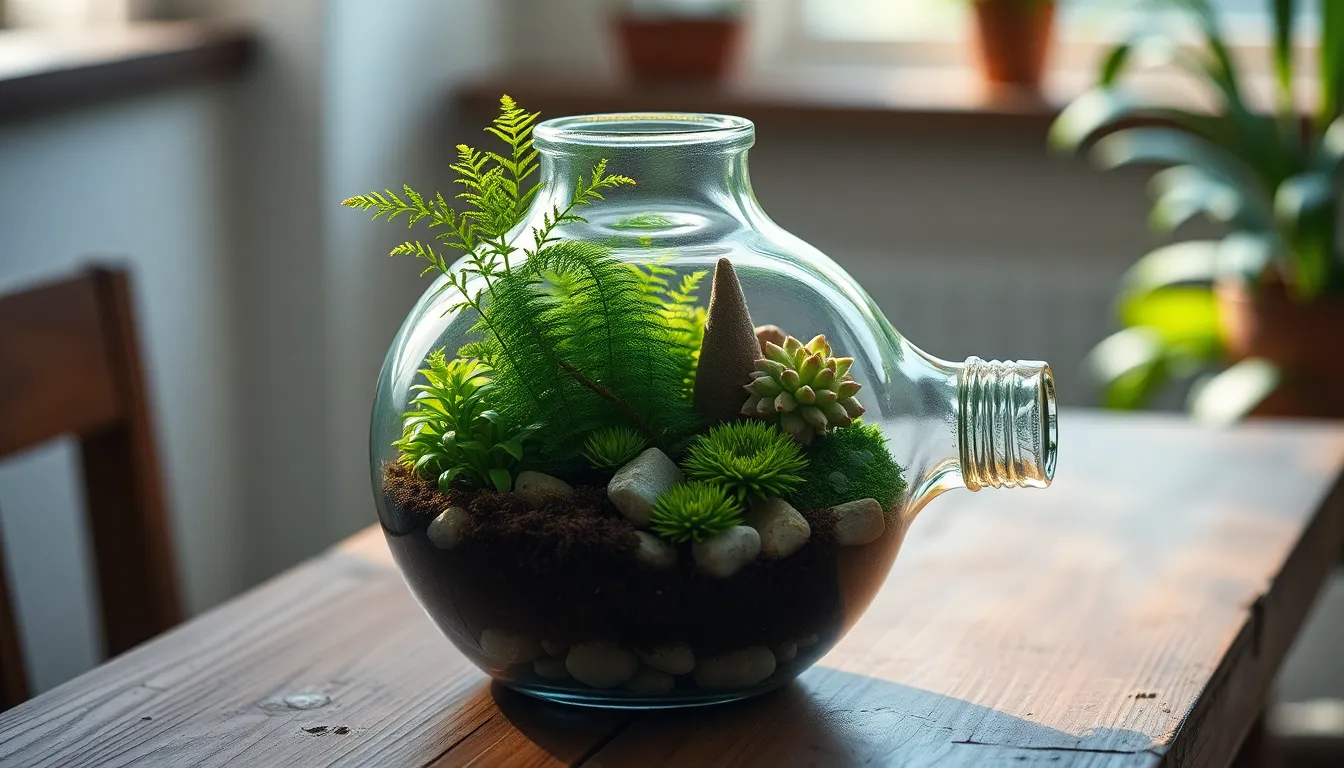
Creating miniature ecosystems inside glass bottles transforms ordinary containers into captivating living displays. These self-contained gardens offer unique growing environments that cater to different plant preferences and maintenance needs.
Crafting Closed Network Terrariums
Closed terrariums in glass bottles create self-sustaining ecosystems where moisture evaporates from plants, condenses on bottle walls, and cycles back into the soil. This natural water cycle sustains plants with minimal external care, making them perfect for busy lifestyles. Moisture-loving plants thrive in these high-humidity environments with limited airflow.
Ideal plant choices include ferns, moss, ivy, fittonia, syngonium, parlor palm, begonias, African violets, and asparagus ferns. These varieties tolerate the humid conditions and adapt well to enclosed spaces. Building your closed terrarium requires careful layering of substrate, charcoal, and soil inside the bottle for proper drainage and plant health.
Sealed bottles maintain optimal humidity levels, though you can open them occasionally if overheating occurs. Monitor temperature and humidity to prevent condensation buildup that might harm your plants. Position your closed terrarium away from direct sunlight to avoid excessive heat that could damage the delicate network.
Designing Open-Top Succulent Gardens
Open-top bottles and jars suit succulents and cacti that require well-draining soil and reduced humidity levels. Wide-neck glass bottles like vintage cookie jars help easy planting and ongoing maintenance of these drought-tolerant plants. Airflow circulation prevents root rot and keeps succulents healthy in their glass homes.
Popular container choices include tequila or whisky bottles with generous openings that accommodate succulent root systems. Plant succulents upright or sideways in bottles with adequate surface area for proper growth. Vintage jars offer rustic charm while providing the open environment succulents need to flourish.
Drainage becomes crucial for succulent bottle gardens since these plants can’t tolerate waterlogged conditions. Layer gravel or small stones at the bottom before adding well-draining succulent soil mix. Water sparingly and allow soil to dry completely between waterings to prevent root problems.
Building Moss and Fern Bottle Landscapes
Mosses and ferns create lush, green bottle landscapes due to their preference for humid, shaded, and enclosed conditions. These plants naturally thrive in the controlled environment that glass bottles provide. Moss covers soil surfaces beautifully while compact ferns add texture and vertical interest to your miniature industry.
Small glass perfume bottles or tiny glass lockets work perfectly for creating miniature moss and fern displays. Choose compact fern varieties that won’t outgrow their containers quickly. Layer different moss types to create depth and visual appeal in your bottle garden.
Maintenance involves keeping humidity levels stable and positioning bottles away from direct strong sunlight to prevent overheating. Mist occasionally if the bottle appears too dry, but avoid overwatering that could lead to mold growth. These enclosed environments maintain their own moisture balance when properly established.
Decorative Table Centerpiece Bottle Plants

Glass bottles transform into stunning centerpiece displays that bring natural beauty to our dining and coffee tables. These elegant plant containers showcase miniature gardens that captivate guests while requiring minimal maintenance.
Arranging Multiple Bottle Plant Displays
Grouping bottles of various shapes and heights creates dimensional appeal that draws the eye naturally across our table space. We can arrange three to five bottles in odd numbers for the most visually pleasing effect, using clear wine bottles alongside mason jars and decorative glass containers.
Air plants, spiderwort, peperomia, and baby’s tears thrive beautifully in these bottle environments. Different plant varieties in each bottle add texture and color contrast that makes our display more captivating. Staggering the heights allows each plant to receive proper light while creating a cascading visual flow.
Clustering bottles near the center of our table leaves room for dining essentials while maintaining the focal point. We position the tallest bottle toward the back with shorter ones stepping forward, ensuring every guest can appreciate the arrangement from their seat.
Creating Seasonal Themed Bottle Gardens
Spring themes come alive with fresh green moss, baby’s tears, and small flowering plants paired with pastel colored stones or tiny figurines. These delicate elements capture the renewal and growth that defines the season perfectly.
Autumn bottles showcase miniature pumpkins alongside hardy succulents and dried leaves that reflect the harvest season’s warmth. We can add amber colored stones or small pinecones to enhance the cozy fall atmosphere our centerpiece creates.
Winter arrangements feature evergreen mini ferns combined with frosted glass beads that evoke a snowy industry effect. Clear bottles filled with white sand or pearl beads create an elegant winter wonderland that brightens darker months.
Summer displays burst with vibrant air plants and colorful stones that mirror the season’s energy. We incorporate bright beach glass or tropical themed elements that transport our dining space to a sunny paradise.
Designing Minimalist Glass Bottle Accents
Clean lines and simple elements define our minimalist approach to bottle plant centerpieces. Single air plants placed in clear glass bottles highlight the natural beauty of both plant and container without overwhelming our table setting.
Uniform bottles arranged in linear patterns create sophisticated displays perfect for modern dining spaces. We select identical clear bottles and place one plant variety in each, maintaining consistency that complements contemporary interior design.
Neutral tones in decorative elements like white sand or clear stones support the minimalist aesthetic beautifully. These subtle accents enhance our plants without competing for attention or disrupting the clean visual flow.
Sparse decorative use maintains focus on the plants themselves rather than busy embellishments. We choose one or two simple elements per bottle, allowing the natural beauty of our chosen plants to serve as the primary design feature.
Outdoor Glass Bottle Garden Projects
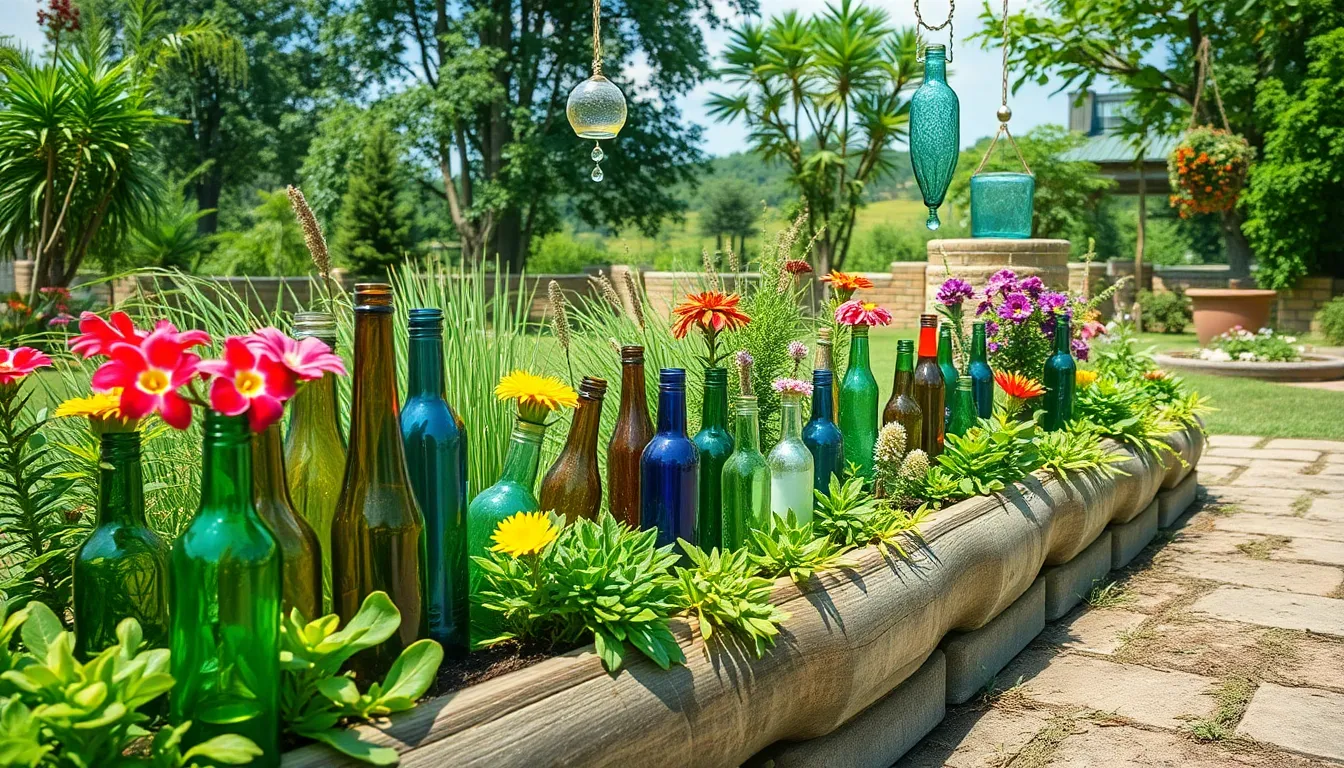
Taking our glass bottle gardening expertise outdoors opens up exciting possibilities for transforming any yard or garden space. Weather resistant bottle planters and artistic displays can enhance your industry while showcasing your creativity.
Building Weather-Resistant Bottle Planters
Weather resistant bottle planters start with selecting sturdy glass bottles that can withstand outdoor elements. We position these containers horizontally or vertically with proper drainage holes to accommodate succulents and small plants effectively.
Smoothing glass edges carefully prevents breakage and ensures safety during handling. Clear and colored glass bottles both provide excellent decorative container effects while protecting your plants.
Strategic placement in sheltered areas protects your bottle planters from wind damage and extreme temperature fluctuations. Stable positioning prevents tipping while maintaining optimal growing conditions for your chosen plants.
Drainage considerations become crucial for outdoor bottle planters since excess water needs somewhere to escape. Pre existing bottle openings work well for this purpose when bottles are positioned correctly.
Creating Garden Border Bottle Displays
Garden border bottle displays transform ordinary pathways into visually stunning industry features. We arrange glass bottles of various colors, sizes, and shapes in lines or patterns along garden bed edges for maximum impact.
Removing labels creates a cleaner aesthetic appearance while leaving them on provides interesting variation as they weather naturally. Both approaches offer unique visual appeal depending on your design preferences.
Mosaic style displays can be created by affixing bottles onto wooden stakes or metal rods for artistic groupings. Wine bottle garden edging involves digging shallow trenches and inserting empty bottles neck down into the ground.
This rustic border technique keeps soil and mulch contained while allowing proper water drainage through the display. The bottles create a functional barrier that adds character to any garden space.
Designing Bottle Plant Rain Catchers
Bottle plant rain catchers use glass bottles turned upside down to collect water for nearby vegetation. We position these simple collectors strategically in garden areas that experience dry conditions.
Vertical garden structures can incorporate bottle rain catchers to enhance both water collection and artistic elements. Rain chains combined with bottle catchers create functional water management systems.
Strategic placement near thirsty plants ensures collected rainwater reaches areas that need moisture most. These catchers work particularly well in xeriscaping or drought prone garden sections.
Integration with existing irrigation systems maximizes water conservation efforts while adding unique visual interest to your outdoor space.
Easy DIY Glass Bottle Cutting Techniques
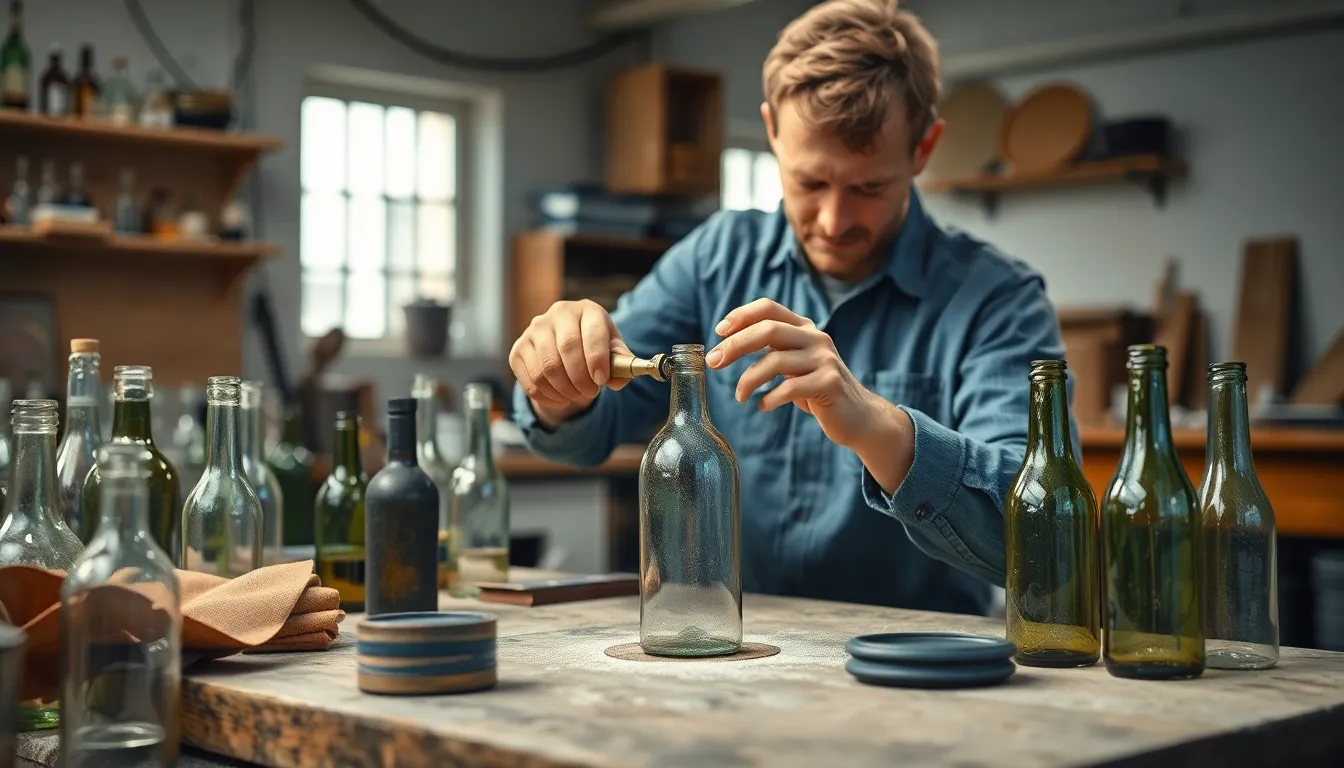
Mastering glass bottle cutting opens up endless possibilities for creating stunning plant containers. We’ll walk you through three proven methods that deliver clean, professional results every time.
Using String and Fire Method
Wrapping a string soaked in acetone or alcohol around your bottle creates the perfect cutting guide. We light the string carefully and let it burn evenly around the entire circumference. Once the flame burns out, we immediately plunge the bottle into cold water to create thermal shock.
This temperature change causes the glass to crack cleanly along the string line within seconds. We’ve found this method works best on bottles with consistent thickness and smooth surfaces. Safety becomes paramount when working with open flames, so we always keep a fire extinguisher nearby and work in a well-ventilated area.
Applying Glass Cutting Tools
Carbide cutters provide the most precise scoring method for glass bottles. We mount the cutter tool on a wooden jig to ensure steady, consistent pressure throughout the cutting process. The carbide tip only needs to protrude a few millimeters from the tool housing for optimal results.
Scoring requires one continuous motion around the bottle’s circumference. We turn the bottle slowly while maintaining even pressure to create a clean score line. Glass cutters work exceptionally well when combined with heating methods, as the scored line provides a predetermined break point.
Finishing Edges for Safety
Sanding the cut edges transforms sharp glass into smooth, safe surfaces for handling. We place sandpaper flat on our work surface and rub the bottle edge against it using circular motions. This technique prevents uneven sanding and creates uniform edge smoothness.
Inner edges require special attention using sandpaper wrapped around a dowel or pencil. We work gradually with progressively finer grits, starting with 120-grit and finishing with 220-grit sandpaper. The entire finishing process typically takes 10-15 minutes per bottle and ensures our glass bottle planters are completely safe to handle and use.
Best Plants for Glass Bottle Growing
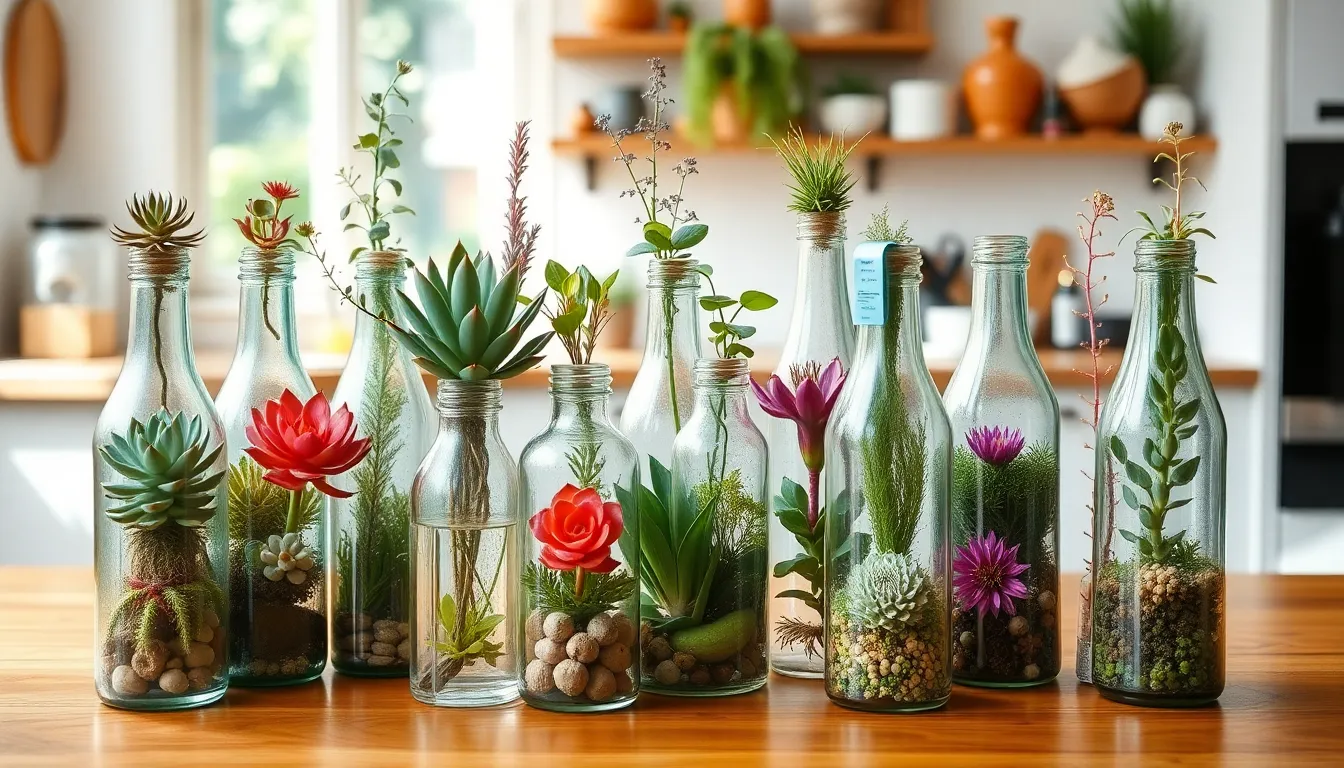
Selecting the right plants for glass bottle gardens determines the success of your project. We’ll explore three categories of plants that thrive in these unique growing environments.
Low-Maintenance Succulent Varieties
Succulents excel in glass containers due to their drought tolerance and minimal care requirements. These resilient plants come in countless varieties and adapt beautifully to the limited space of jars and bottles. Plants like echeveria, jade plants, and string of pearls create stunning displays while requiring watering only every 2-3 weeks.
Open or semi-open glass containers work best for succulent bottle gardens since excess water can evaporate naturally. This prevents the root rot that often kills succulents in closed systems. Popular varieties include hens and chicks, which multiply to fill your bottle garden, and colorful sedums that add vibrant hues to your display.
Placement near bright, indirect light keeps these plants healthy without the risk of overheating in glass. We recommend choosing smaller succulent varieties that won’t outgrow their bottle homes quickly, such as baby jade or miniature aloe species.
Air Plants Perfect for Bottle Life
Tillandsia species, commonly known as air plants, absorb moisture and nutrients directly from the air without needing soil. Their unique growing method makes them perfect candidates for decorative glass bottles and creative terrarium displays. These plants eliminate the mess of soil while creating visually striking arrangements.
Air plants can be placed on decorative stones inside bottles or suspended with fishing line for floating effects. Popular varieties include Tillandsia ionantha, which turns bright red when blooming, and Tillandsia xerographica, known for its silvery, curling leaves.
Misting air plants once or twice weekly provides adequate moisture, while their compact size fits perfectly in wine bottles and mason jars. We suggest grouping different air plant varieties together for textural contrast and visual interest in larger bottle displays.
Small Herb Species for Bottle Gardens
Small herb varieties transform glass bottles into functional kitchen gardens that combine beauty with practicality. Herbs like rosemary, small basil varieties, and compact mint species thrive in glass containers when provided with adequate light and regular water changes.
Kitchen window sills provide ideal conditions for bottle herb gardens, offering bright light and easy access for cooking. We recommend using filtered or bottled water to prevent mineral buildup that can harm delicate herb roots over time.
Compact oregano and thyme varieties work exceptionally well in bottle gardens, requiring minimal space while producing flavorful leaves for cooking. These herbs can grow in water alone or be transplanted to soil-filled bottles with proper drainage holes for longer-term cultivation.
Creative Glass Bottle Plant Display Ideas
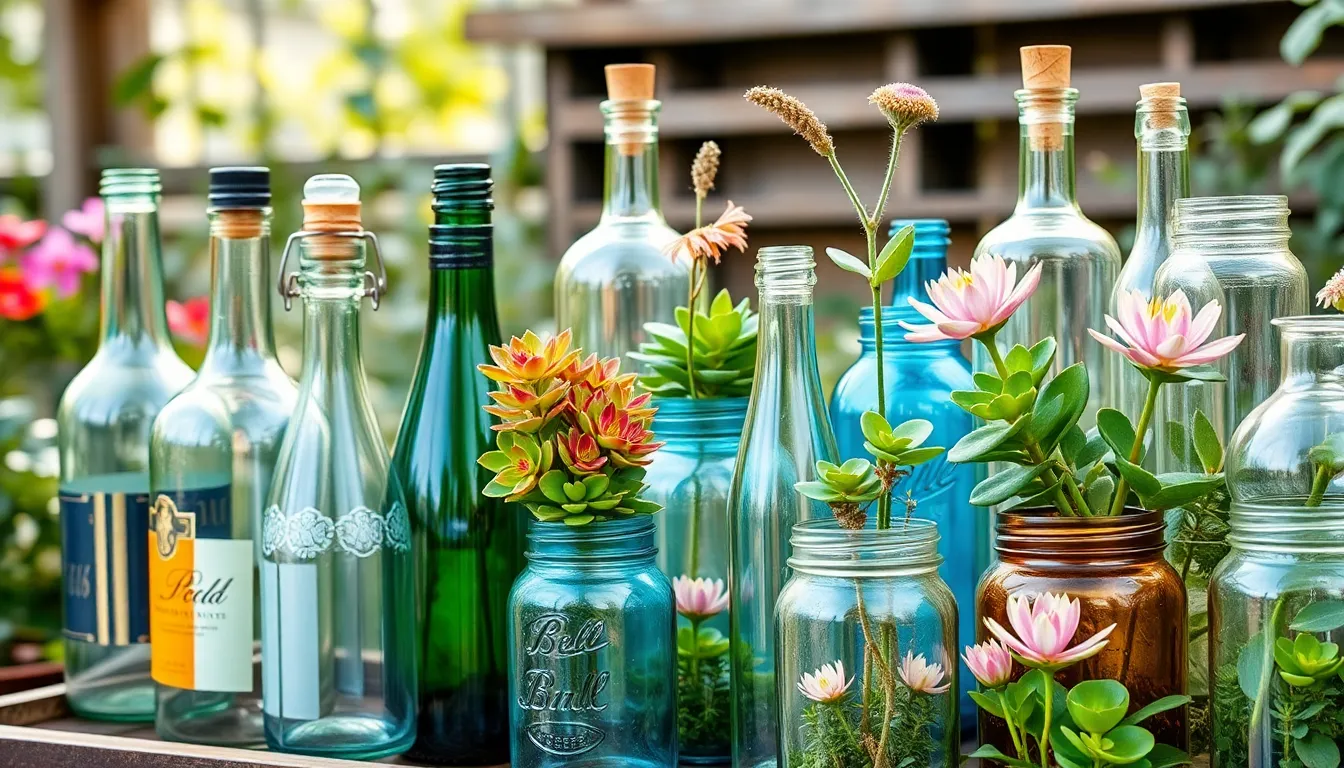
We’ve explored the basics of glass bottle gardening, and now it’s time to elevate your displays with innovative techniques that transform simple bottles into stunning focal points.
Floating Bottle Gardens in Water Features
Transform your water features into enchanting displays by repurposing glass bottles as floating planters. We can create these unique installations by partially submerging clear wine bottles or mason jars in ponds, water bowls, or decorative basins.
The transparent nature of glass bottles enhances the reflective quality of water while maintaining perfect buoyancy for your chosen plants. Aquatic plants like water lettuce, water hyacinth, and small lily varieties thrive in these floating systems. We recommend securing drainage holes near the waterline to prevent overflow while maintaining proper water circulation.
Position floating bottle gardens strategically to catch natural light reflections throughout the day. The combination of glass transparency and water movement creates ever-changing visual interest that changes with lighting conditions and seasons.
Grouping Different Sized Bottle Planters
Create dimensional displays by clustering glass bottle planters of varying heights, shapes, and colors across your indoor shelves or outdoor garden spaces. We suggest combining classic wine bottles with teardrop shapes, round bulbs, square flasks, vintage milk bottles, and apothecary jars for maximum visual impact.
Organize your bottle groupings using three key design principles: color coordination, size graduation, and plant variety. Start with the tallest bottles as backdrop anchors, then layer medium and small containers in the foreground. We find that odd numbered groupings of three, five, or seven bottles create more natural, pleasing arrangements.
Theme your clusters by plant type or seasonal colors to establish cohesive focal points. Succulent groupings work beautifully with clear and blue glass bottles, while herb collections shine in green and amber containers. Mix textures by pairing smooth wine bottles with textured mason jars or vintage milk bottles.
Incorporating LED Lighting Effects
Illuminate your glass bottle gardens with LED strip lights or battery operated fairy lights to create stunning nighttime displays. We can weave these lights inside larger bottles or wrap them around the exterior to transform ordinary planters into glowing art pieces.
Install LED strips along the bottom of clear bottles containing air plants or small succulents to create an upward glow effect. The glass acts as a natural diffuser, softening harsh LED light into gentle ambient illumination. We recommend warm white or soft yellow LEDs for cozy indoor atmospheres.
Create dramatic outdoor lighting by positioning solar powered LED stakes near bottle garden clusters. These lights can spotlight exact arrangements while providing pathway illumination. Battery operated string lights offer flexibility for temporary displays during garden parties or seasonal celebrations.
Timer controlled LED systems allow us to automate lighting schedules, ensuring your bottle gardens become evening focal points without daily manual activation. We suggest 4 to 6 hour evening cycles to maximize battery life while maintaining consistent visual appeal.
Maintenance Tips for Glass Bottle Plants
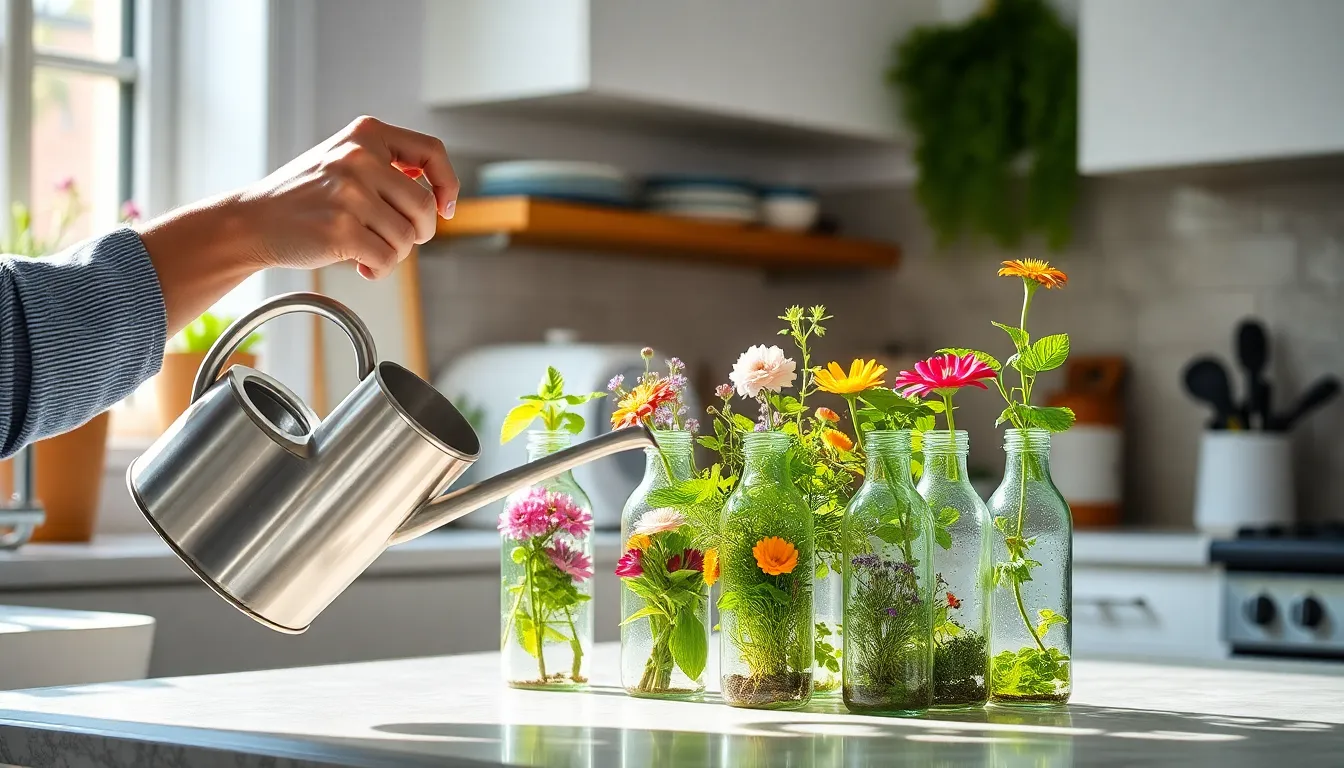
Successfully maintaining glass bottle plants requires attention to exact care techniques that differ from traditional container gardening. We’ll guide you through essential maintenance practices that keep your bottle gardens thriving and beautiful.
Watering Techniques for Bottle Gardens
Careful watering becomes crucial since most bottle gardens lack drainage holes. Overwatering poses the greatest threat to bottle garden health because excess water cannot escape and leads to root rot. We recommend starting with minimal water and gradually adding more as needed rather than risking oversaturation.
Water your bottle garden slowly and deliberately using a small watering can or squeeze bottle. Add water in small amounts to ensure even distribution among all plants. Let the garden remain open for one full week after watering to allow proper air circulation and moisture adjustment before sealing with a lid or cork.
Monitor your sealed bottle garden for proper moisture levels through condensation patterns. Light condensation on the glass indicates healthy humidity levels while heavy fogging suggests overwatering. We suggest opening the container temporarily if excessive moisture appears and allowing some evaporation before resealing.
Replace water weekly in water propagated plants to maintain freshness. Stagnant water develops bacteria and algae that harm plant roots and overall garden health. Fresh water provides essential nutrients and prevents the development of harmful microorganisms.
Preventing Algae Growth in Clear Containers
Regular cleaning prevents algae buildup that clouds glass and competes with plants for nutrients. We recommend cleaning bottles weekly using soap and a bottle brush or old toothbrush to scrub away any green film. Clean glass allows maximum light penetration for healthy plant photosynthesis.
Adding activated charcoal to your growing medium creates a natural filtration system. Small amounts of activated charcoal absorb excess moisture and toxins that promote algae growth. This natural additive helps maintain a fresh environment and counteracts the effects of occasional overwatering.
Position bottle gardens away from direct sunlight to prevent algae promoting conditions. Glass containers magnify sunlight intensity which encourages rapid algae development and can damage delicate plants. We suggest placing bottle gardens in bright indirect light locations such as north facing windows or areas with filtered natural light.
Sterilize bottles and use sterile growing mediums to prevent contamination from the start. Clean containers with a diluted bleach solution before planting and choose commercial potting mixes designed for houseplants. These preventive measures eliminate algae spores and harmful bacteria before they can establish in your bottle garden.
Pruning and Plant Care in Confined Spaces
Trim rotting or dead plant parts immediately to prevent decay from spreading throughout the confined space. Use small scissors or tweezers to remove damaged leaves, stems, and roots with precision. Quick removal of unhealthy plant material maintains the overall health of your bottle garden network.
Clean plant leaves regularly to remove dust and ensure proper gas exchange. Dust accumulation on leaves blocks light absorption and reduces photosynthesis efficiency. We recommend gently wiping leaves with a damp cotton swab or soft brush to maintain their natural shine and function.
Monitor plant growth space and prune to prevent overcrowding in the limited bottle environment. Plants that grow too large for their containers experience stress and compete for resources. Regular pruning maintains appropriate plant size and ensures each plant receives adequate light and air circulation.
Remove flowering plants or spent blooms promptly since fading flowers decay quickly in humid bottle conditions. Decomposing plant material creates ideal conditions for fungal growth and attracts pests. We suggest choosing non flowering plants for bottle gardens or selecting varieties with easily accessible blooms for regular maintenance.
Apply minimal fertilizer using controlled release formulas once yearly or diluted organic fertilizers sparingly. Confined spaces concentrate nutrients quickly and overfertilization leads to rapid unwanted growth. Use quarter strength liquid fertilizer only when plants show signs of stunted growth or pale coloring.
Conclusion
Glass bottle gardens offer us endless possibilities to transform ordinary containers into extraordinary green spaces. We’ve explored everything from simple herb gardens to complex hanging displays that maximize our vertical space potential.
These versatile planters work beautifully whether we’re creating indoor terrariums or weather-resistant outdoor displays. The best part? We can achieve stunning results with minimal investment and basic DIY skills.
Remember that success comes from choosing the right plants for our exact containers and maintaining proper care routines. With these techniques we can enjoy thriving bottle gardens that bring natural beauty to any space we choose.
Frequently Asked Questions
What are glass bottle gardens and why are they popular?
Glass bottle gardens are miniature ecosystems created inside glass containers like wine bottles and mason jars. They’re popular because they require minimal maintenance, fit perfectly in small spaces, and add natural beauty to any environment. Anyone can create them regardless of gardening experience, making them ideal for busy lifestyles and urban living.
What types of glass containers work best for bottle gardens?
Wine bottles, mason jars, large glass bottles, and clear containers work excellently for bottle gardens. Choose containers based on your plant selection – narrow bottles suit air plants, while wider containers accommodate succulents and herbs. Clear glass allows maximum light penetration for healthy plant growth.
Which plants are best suited for glass bottle growing?
The best plants for glass bottle gardens include low-maintenance succulents (echeveria, jade plants), air plants (tillandsia varieties), and small herbs (basil, oregano, cilantro). These plants thrive in confined spaces and adapt well to the unique growing conditions inside glass containers.
How do you cut glass bottles safely for gardening projects?
Use the “String and Fire Method” by wrapping string around the bottle, soaking it in flammable liquid, lighting it, then immediately placing in cold water. Alternatively, use glass cutting tools for precise scoring. Always sand cut edges smooth to prevent injury and ensure safe handling.
How do you maintain glass bottle plants properly?
Water carefully using minimal amounts since most bottle gardens lack drainage holes. Monitor condensation patterns to gauge moisture levels. Clean containers regularly to prevent algae growth, add activated charcoal for freshness, and prune plants to prevent overcrowding. Use minimal fertilizer to avoid over-feeding.
Can glass bottle gardens be used outdoors?
Yes, glass bottle gardens work outdoors with proper preparation. Use weather-resistant containers and ensure adequate drainage. Place them strategically to protect from strong winds and temperature fluctuations. They make excellent garden borders, pathway decorations, and can even function as rain catchers for irrigation.
What are some creative display ideas for glass bottle gardens?
Create floating bottle gardens in water features, group different-sized planters for dimensional displays, or add LED lighting for nighttime effects. Consider seasonal themed arrangements, minimalist designs, or tiered hanging systems to maximize vertical space and visual appeal.
How do self-watering bottle systems work?
Self-watering systems use wine bottles inverted into plant containers, creating a reservoir that slowly releases water as needed. This maintains consistent moisture levels without overwatering, making herb cultivation easier and more efficient while reducing maintenance requirements.

